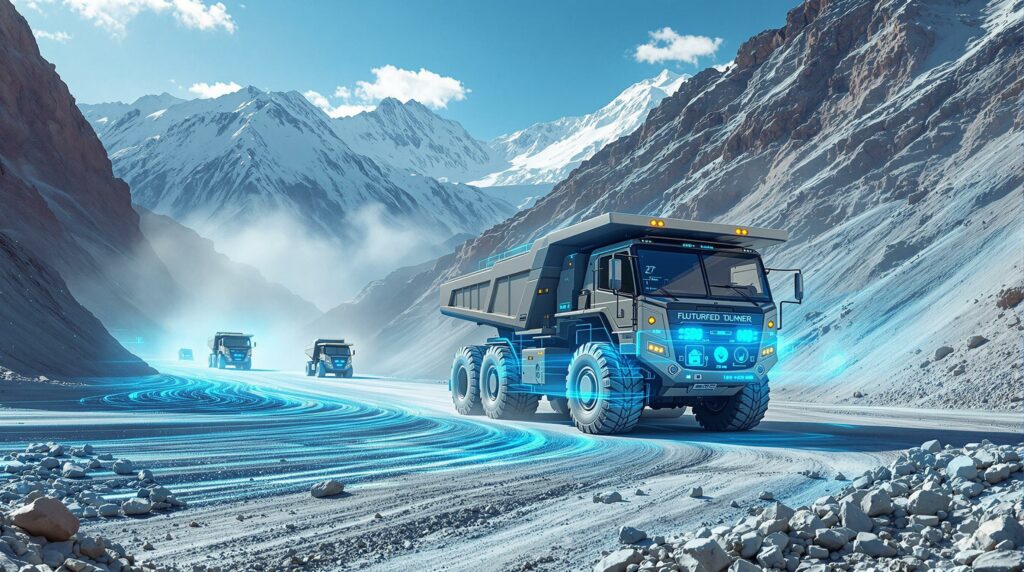The Julong Copper Mine: A Case Study in Extreme Mining Conditions
Mining operations have always faced significant challenges, but few test the limits of human endurance and technological capability quite like high-altitude mining. The Julong Copper Mine in western China stands as a remarkable example of how EACON drives autonomy at high altitude copper mine operations, transforming one of the world's most extreme environments.
The Challenges of High-Altitude Mining
Operating at elevations between 4,000 and 5,400 meters above sea level, the Julong Copper Mine presents a formidable set of challenges that conventional mining approaches struggle to overcome.
Oxygen Deprivation: At these extreme altitudes, oxygen levels are approximately 40% lower than at sea level, severely affecting human cognitive function, physical capabilities, and overall health. Workers commonly experience altitude sickness, fatigue, and decreased decision-making abilities.
Extreme Weather Conditions: Temperatures can plummet well below freezing, with unpredictable weather patterns including sudden snowstorms, high winds, and severe visibility limitations. These conditions not only affect human comfort but also impact equipment reliability.
Equipment Performance Issues: Standard mining equipment faces significant stress at high altitudes. Engines struggle with reduced oxygen, cooling systems operate less efficiently, and specialized modifications are often required to maintain operational capacity.
"The combination of low oxygen, extreme cold, and rugged terrain creates an environment where traditional mining approaches reach their limits. Every aspect of the operation must be reconsidered with these constraints in mind." — Mining operations expert
Recruitment and Retention Challenges: Finding qualified personnel willing to work in such extreme conditions represents a significant operational bottleneck. The physical demands, health concerns, and remote location make staffing these operations particularly difficult.
Safety Considerations: The harsh environment multiplies safety risks. Drivers face impaired judgment due to altitude effects, challenging visibility conditions, and the physical stress of operating heavy machinery in a low-oxygen environment.
What Makes Julong Copper Mine Significant?
The Julong Copper Mine stands out not only for its operational challenges but also for its strategic importance to global copper investment opportunities.
World-Class Resource: Ranked among the world's top five copper deposits, Julong represents a crucial strategic resource for China's growing demand for this essential metal. The deposit's size and grade make it an attractive target despite the operational complexities.
Geographic Importance: Located in western China's copper belt, Julong forms part of a significant mineral cluster that is reshaping global copper supply chains. Its development reflects China's broader strategy to secure domestic supplies of critical minerals.
Multi-Deposit Operation: The mine encompasses both the Julong and Zhibula mining zones, creating a complex operational environment that requires coordinated management across varied terrain and conditions.
Supply Chain Significance: As global copper demand continues to rise, driven by renewable energy technologies, electric vehicles, and infrastructure development, deposits like Julong gain increasing strategic importance despite their operational challenges.
Pioneering Status: Due to its extreme conditions, successful innovations at Julong often establish new benchmarks for the global mining industry evolution, particularly in the realm of autonomous operations and worker safety.
How EACON's Autonomous Technology is Revolutionizing High-Altitude Mining
The implementation of autonomous haulage at Julong represents a transformative approach to addressing the challenges of high-altitude mining operations.
Phase One Implementation: Mixed Fleet Operations
The initial deployment of autonomous technology at Julong has demonstrated promising results in one of mining's most challenging environments.
Strategic Fleet Deployment: Phase One saw the successful launch of five 100-tonne autonomous dump trucks working alongside seven 200-tonne manned vehicles, creating a mixed fleet operation that allows for gradual technology adoption.
Safety Performance: Perhaps most significantly, the autonomous operation has maintained a perfect safety record with zero incidents reported during the mixed fleet operations — a remarkable achievement given the environmental challenges.
Operational Validation: The successful implementation serves as a proof of concept for autonomous mining technology in extreme environments, confirming that these systems can function reliably despite the harsh conditions.
Human Factor Benefits: By removing operators from exposure to low-oxygen environments, the autonomous system has eliminated a significant health and safety concern while simultaneously addressing recruitment challenges.
Productivity Improvements: Initial operational data suggests more consistent production levels with autonomous vehicles, which don't suffer from the fatigue and cognitive impairment that affect human operators at high altitudes.
What Makes EACON's Autonomous System Unique?
EACON's approach to mining autonomy incorporates several distinctive features that address the specific challenges of high-altitude operations.
Manufacturer-Independent Architecture: Unlike many competing systems that are tied to specific OEMs, EACON's technology works across different truck manufacturers and models, providing flexibility for mixed fleet operations.
Retrofit Capabilities: The system offers the ability to upgrade existing fleet vehicles to autonomous operation, allowing mines to transform their current equipment without wholesale replacement.
Factory Integration Options: For new equipment purchases, the technology can be integrated during manufacturing, optimizing the installation process and ensuring seamless operation.
Multi-Powertrain Compatibility: The autonomous system functions with both conventional diesel and electric vehicles, creating a forward-compatible platform that supports the transition to more sustainable mining transformation.
Environmental Adaptability: Perhaps most importantly for Julong, the system has demonstrated reliable performance in extreme conditions where other technologies might falter, with specialized adaptations for high-altitude operations.
"To introduce autonomous haul trucks at such altitude and under these conditions is a milestone for industry safety and productivity. It has removed the need for drivers to work in extreme environments, significantly enhancing safety while easing operational constraints." — Julong mine superintendent
The Future of Mining Autonomy at Julong
Building on the successful initial implementation, Julong is now advancing toward more comprehensive autonomous operations across its mining zones.
Phase Two Expansion: Scaling Autonomous Operations
The second phase of autonomy at Julong represents a significant scaling of capabilities and ambition.
Larger Vehicle Integration: Phase Two includes retrofitting 240-tonne mining trucks for autonomous operation, applying the proven technology to larger vehicles that handle greater material volumes.
Intelligent Fleet Management: The implementation of the ORCASTRA CONDUCTOR system will provide advanced fleet optimization capabilities, coordinating vehicles of different sizes and types across multiple mining zones.
Cross-Brand Coordination: The system's ability to work with equipment from different manufacturers enables the mine to select the optimal vehicle for each specific task rather than being limited to a single supplier's offerings.
Productivity Optimization: Advanced algorithms will continuously optimize routes, loading and dumping sequences, and maintenance schedules to maximize operational efficiency across the entire fleet.
Scalable Approach: The phased implementation demonstrates how autonomous mining can be gradually expanded, allowing operations to adapt their processes and personnel while minimizing disruption.
Zhibula Copper Mine: The Next Frontier in Mining Innovation
The nearby Zhibula mining zone represents the next phase in Julong's autonomous journey, with plans that integrate multiple cutting-edge technologies.
Electric Autonomous Fleet: The plan calls for the deployment of 60 factory-fitted battery-electric autonomous trucks, combining autonomy with electrification for a dual technological transformation.
Infrastructure Adaptations: Zhibula's distinct terrain requires specialized modifications to accommodate narrower roads and different equipment profiles, demonstrating the system's adaptability to varied mining environments.
Environmental Impact Reduction: By eliminating both human operators and diesel emissions, the Zhibula implementation represents a significant advance in mining sustainability at high altitudes.
Model Operation Status: The site is positioned to become a flagship demonstration of how mining can simultaneously address safety, operational, and environmental challenges through technological innovation.
Technology Convergence: This implementation represents one of the industry's most ambitious combinations of autonomous operation and electrification in an extreme environment.
What Are the Broader Implications for Mining Innovation?
The developments at Julong point toward wider industry transformations that could reshape mining practices globally, particularly in challenging environments.
How Autonomy Addresses Mining's Persistent Challenges
Beyond the specific case of high-altitude operations, autonomous mining offers solutions to several industry-wide challenges.
Safety Transformation: By removing humans from hazardous environments, autonomous systems fundamentally change the safety equation for mining operations, potentially eliminating many categories of workplace accidents.
Labor Market Solutions: Autonomy addresses the growing global challenge of recruiting skilled operators, particularly for remote locations or difficult working environments.
Operational Consistency: Autonomous systems maintain consistent productivity levels regardless of time of day, weather conditions, or other factors that typically impact human performance.
Cost Structure Improvements: Over time, autonomous operations can reduce labor costs, accident-related expenses, and insurance premiums while increasing equipment utilization rates.
Performance Optimization: Data-driven mining innovations lead to measurable improvements in throughput and equipment utilization that are difficult to achieve with manual operations.
The Convergence of Autonomy and Sustainability
The Julong case illustrates how autonomous technology is increasingly aligned with broader sustainability goals in mining.
Emissions Reduction Potential: The combination of electric powertrains with autonomous operation represents a pathway to significantly reduced carbon emissions from mining operations.
Resource Efficiency: Intelligent fleet management systems optimize fuel or energy use, reduce unnecessary vehicle movements, and minimize idle time.
Environmental Monitoring Integration: Autonomous vehicles can be equipped with environmental monitoring sensors to collect real-time data on air quality, dust levels, and other environmental parameters.
Regulatory Adaptation: As environmental regulations become more stringent globally, integrated autonomous-electric systems position mining operations to meet future compliance requirements.
Industry Leadership Opportunities: Early adopters of these combined technologies gain potential competitive advantages in both operational efficiency and environmental performance.
"EACON's implementation is setting new benchmarks for safety, resilience, and sustainability in global mining, proving that autonomous haulage can succeed in one of the world's highest and harshest sites."
FAQ: Autonomous Mining in Extreme Environments
What are the primary benefits of autonomous mining at high altitudes?
Autonomous mining at extreme altitudes provides multiple advantages:
- Elimination of altitude-related health risks for human operators
- Consistent productivity regardless of oxygen levels or environmental conditions
- Reduced recruitment challenges in remote, difficult environments
- Lower accident rates due to removal of human factors like fatigue or impaired judgment
- Extended operational hours without shift changes or rest periods
- Standardized performance unaffected by operator skill variations
How does autonomous technology perform in extreme weather conditions?
Modern autonomous mining systems incorporate several features to ensure reliable operation in harsh conditions:
- Multi-sensor fusion combining radar, LiDAR, cameras, and GPS for redundancy
- Advanced machine learning algorithms that adapt to changing visibility conditions
- Specialized hardware designed for extreme temperature ranges
- Redundant communication systems to maintain connectivity in adverse weather
- Predictive maintenance systems that account for environmental stress factors
What safety protocols are implemented for mixed autonomous and manned fleets?
Safe mixed fleet operations require comprehensive systems and procedures:
- Clearly defined operational zones with distinct areas for autonomous and manned vehicles
- Real-time positioning systems tracking all vehicles regardless of autonomous status
- Priority protocols governing interaction between autonomous and manned equipment
- Emergency override capabilities allowing human intervention when necessary
- Comprehensive training programs for all personnel working alongside autonomous equipment
- Visual identification systems making autonomous vehicles easily recognizable
How does the transition to autonomous mining affect the workforce?
The shift to autonomy creates a complex workforce transformation:
- Reduction in traditional operator roles in hazardous environments
- Creation of new positions in fleet management and systems monitoring
- Skills evolution toward higher technology competencies
- Relocation of some roles from mine sites to remote operations centers
- Increased demand for maintenance specialists with both mechanical and technological expertise
- Training and upskilling opportunities for existing workers
What infrastructure modifications are needed to support autonomous mining?
Successful implementation typically requires several infrastructure adaptations:
- Enhanced connectivity infrastructure including wireless networks with redundant coverage
- Specialized loading and dumping zones designed for autonomous vehicle patterns
- Modified haul roads with appropriate width, grade, and surface conditions
- Advanced fleet management centers with monitoring and control capabilities
- Charging or refueling infrastructure designed for autonomous access
- Upgraded maintenance facilities equipped to service autonomous systems
Comparing Mining Automation Technologies
| Feature | Traditional Mining | Semi-Autonomous | Fully Autonomous |
|---|---|---|---|
| Human Operators | Required on-site | Remote operation | Minimal supervision |
| Safety Exposure | High risk in extreme environments | Moderate risk | Minimal human exposure |
| Operational Hours | Limited by shift changes | Extended through remote operation | 24/7 capability |
| Weather Impact | Significant downtime | Moderate impact | Minimal disruption |
| Implementation Cost | Lower initial investment | Moderate investment | Higher initial investment |
| Long-term ROI | Lower | Moderate | Highest potential |
| Altitude Limitations | Significant human factors | Reduced limitations | Minimal limitations |
| Fleet Coordination | Manual management | Semi-automated | Fully integrated |
| Data Collection | Limited, operator-dependent | Enhanced | Comprehensive |
| Maintenance Approach | Reactive/scheduled | Condition-based | Predictive/preventive |
| Fuel Efficiency | Operator-dependent | Improved | Optimized |
| Operational Consistency | Variable | Standardized | Highly consistent |
Key Takeaways: The Future of High-Altitude Mining
Proven Viability: The successful implementation at Julong demonstrates that EACON drives autonomy at high altitude copper mine operations reliably in one of the world's most challenging mining environments, opening possibilities for other extreme-condition operations globally.
Phased Implementation Advantages: The gradual approach taken at Julong—starting with a limited autonomous fleet operating alongside conventional equipment—provides a model for risk-managed technology adoption.
Technology Convergence: The combination of autonomous operation with electric powertrains at Zhibula represents a significant step toward more sustainable mining practices, addressing both safety and environmental challenges simultaneously.
Flexible Technology Architecture: EACON's OEM-agnostic approach provides mines with greater flexibility in equipment selection and fleet composition, avoiding vendor lock-in while enabling mixed fleet operations.
Safety Transformation: By removing humans from hazardous high-altitude environments, AI in mining operations fundamentally changes the safety equation, potentially eliminating entire categories of workplace risks.
Operational Resilience: Autonomous systems can maintain consistent productivity levels regardless of environmental conditions that would otherwise impact human operators, creating more predictable operations.
Industry Benchmarking: As highlighted by Australian Mining, successful implementations in extreme environments establish new standards for mining operations globally, demonstrating what's possible even under the most challenging conditions.
Disclaimer: This article contains forecasts and speculative analysis regarding future mining technology implementation. Actual results may vary based on specific operational conditions, regulatory environments, and technological developments. The information presented is based on current industry knowledge and should not be considered financial or investment advice.
Ready to Catch the Next Major Mineral Discovery?
Discovery Alert's proprietary Discovery IQ model instantly notifies investors of significant ASX mineral discoveries, turning complex data into actionable investment opportunities before the broader market recognises their potential. Explore historic discoveries and their exceptional returns on our dedicated discoveries page and begin your 30-day free trial today to gain a market-leading advantage.




